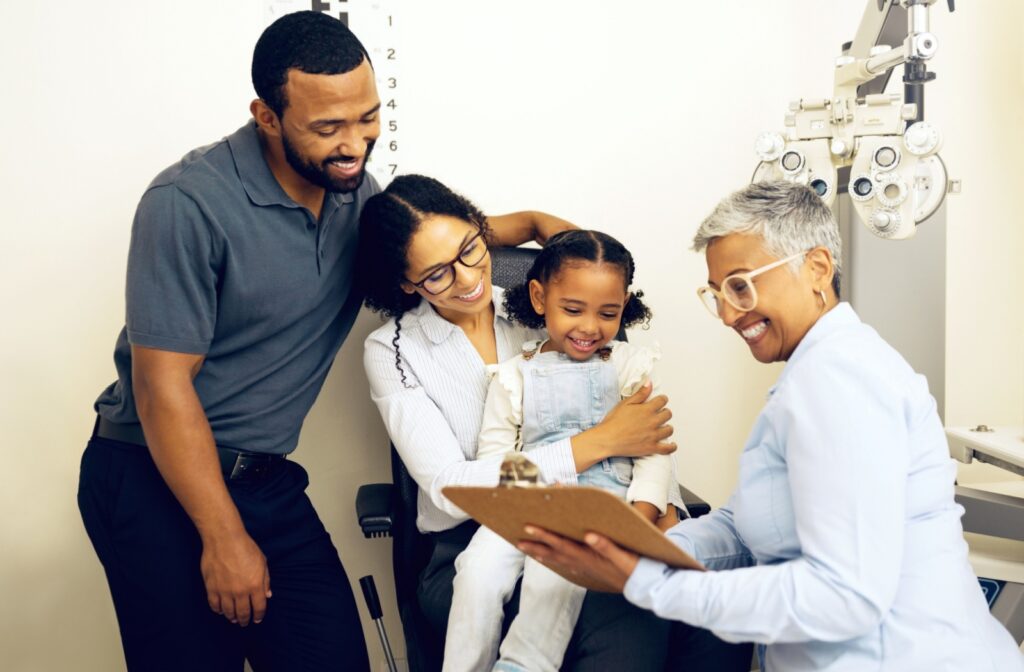Myopia is a common eye condition affecting both children and adults globally. Myopia develops in childhood, and if left untreated it can worsen as we grow older.
Myopia can’t be cured. However, several treatments are available to help manage and slow myopia progression with age.
Some adults may notice the benefits of myopia management but early intervention during childhood is key for myopia control.
What Is Myopia?
Myopia, also known as nearsightedness, is a common condition appearing in roughly 30% of the US population. It’s a refractive error that results in distant objects appearing blurry while objects close by can be seen clearly.
Fortunately, it can be corrected in several ways, enhancing quality of life, and reducing the risks of eye conditions associated with untreated myopia.
Common symptoms associated with myopia include:
- Headaches
- Eye strain
- Blurry distance vision
- Squinting to see clearly
An eye without refractive error is round. When light enters the eye through the lens and is refracted by the cornea, light focuses directly on the retina, resulting in clear vision.
An eye with myopia is not round, but rather elongated. When light enters the eye through the lens and is refracted by the cornea, light focuses in front of the retina instead of directly on it, resulting in blurry distance vision.
Myopia Development
Myopia can develop at any age but commonly, we see myopia begin to develop between the ages of 6 and 14. Myopia affects 5% of preschool-aged children and 9% of elementary-aged children in the U.S.
Genetics and environmental factors influence myopia development, including if a child:
- Has at least one parent with myopia
- Spends less time outdoors
- Has prolonged exposure to close-up work
Our eyes grow significantly during infancy and childhood. This is why we may see changes in our vision prescription during these years. Our eyes stop growing at around age 20 and our vision prescription stabilizes, making childhood and adolescence an important time for myopia improvement.
Can Myopia Improve with Age?
There is a common belief that myopia can improve with age. While it’s true that eyes change as we age, myopia doesn’t typically improve naturally. Some adults may experience a slight improvement between 40 and 50 years old. Unfortunately, this may have to do with the onset of developing cataracts or presbyopia.
Myopia cannot be cured, but it can be managed to slow its progression. These treatments work by altering the eye’s focusing mechanism or reducing eye strain so the shape of the eye doesn’t continue to elongate.
The best time to start myopia control is during childhood when eyes are still growing and most susceptible to changes. Myopia management can begin in children as early as 4, but most commonly starts from ages 6 to 8.
Myopia control is not exclusively for children. Adults can also benefit, although the effectiveness may vary. Early intervention maximizes the chances of slowing myopia progression and maintaining vision quality.
Importance of Myopia Control
Myopia itself isn’t a serious eye condition. However, leaving it unmanaged can cause myopia to worsen with age or lead to the development of high myopia. High myopia is defined as having a refractive error of -6.00 diopters or greater.
Individuals with high myopia are at an increased risk for developing eye conditions later in life, such as:
- Cataracts
- Glaucoma
- Myopic maculopathy
- Retinal detachment
- Retinal tears
The rate of myopia progression varies among individuals and is detected during comprehensive eye exams. To avoid worsening or high myopia, proactive myopia control strategies are necessary to safeguard long-term vision and ocular health.

Treatments for Myopia Control
Several treatment options for myopia management are available. The optometrist determines the most suitable form and duration of treatment. The journey of myopia management includes being consistent with treatment and regular follow-up visits with your optometrists.
Low-Dose Atropine Drops
These are some of the most common forms of myopia management. Atropine is a medicated eye drop used to dilate the pupils and relax the eye’s focusing mechanism. A single drop is applied once a day to each eye before bed.
Studies show that low-dose atropine drops can effectively slow myopia progression in children between the ages of 4 to 16. There’s no evidence that these drops help slow myopia progression in young adults.
Orthokeratology Lenses
Orthokeratology (ortho-k) lenses are specially designed hard contact lenses designed for overnight wear. While worn overnight, these lenses temporarily reshape the cornea, providing clear vision during the day without the need for glasses or contacts. The effects of corneal reshaping are temporary, so the lenses must be worn nightly to maintain clear vision.
This reshaping reduces the refractive error, allowing light to focus correctly on the retina. Some studies show that eye elongation can be slowed when light rays focus directly on the retina. This process acts as a stop signal for eye growth.
Unlike atropine drops, ortho-k lenses are the only treatment that shows evidence of slowing myopia progression in young adults, up to age 29. They are also an effective treatment option for teenagers.
Multifocal Soft Contact Lenses
Multifocal soft contact lenses include distance and reading vision correction, providing different zones of focus for children. They help slow myopia progression by reducing eye strain and focusing mechanisms. Studies show that these contacts can help slow myopia progression in children from 7 to 16 years old.
Unlike ortho-k lenses, soft contact lenses aren’t designed for overnight wear. Maintaining proper wear and care of these lenses is important for reducing the risk of eye irritation.
Bifocal Glasses
Like multifocal soft contacts, bifocal glasses have two distinct optical powers, one for distance and one for reading. They help manage myopia by reducing eye strain. Bifocals have been shown to reduce myopia progression in children 8 to 13 years old.
Schedule an Appointment
Several treatment options are available to help slow myopia progression. Early intervention with myopia management is key, though young adults may also benefit from these treatments.
Connect with our team at Restore Vision Center to schedule your myopia control appointment.




